Content for TS 22.259 Word version: 18.0.1
A.3 Use case of PN-User access a PLMN from their PNEs
A.4 Use case for connection between guest UE and PN
A.5 Use case on UE redirection of terminating services
A.3 Use case of PN-User access a PLMN from their PNEs p. 19
Figure 7 shows a use case where a user terminates a video service with a PNEs, which is part of a PAN of the PN-User. In this use case the user has multiple PNEs. It is assumed that the required PNE can communicate with the PNE containing the USIM through PAN internal communication means when they are in close proximity. After authentication of the PNEs by the PLMN through the PNE holding the (U)SIM, the user can access the video service. The PNM has the capability to manage the UE components as a user's PAN. It shall have a binding table between the PNE holding the (U)SIMand the other PAN PNEs which includes their identities and addresses.
Figure 8 shows a use case where a user utilizes a video service through PNEs that have their own network access means and thus a direct access means to a PNM. PNEs attached to a UE don't have their own USIM and may or may not have their own access means. The PNE holding the (U)SIM can authenticate these other PNEs to the PLMN when these PNEsare in close proximity to the UE. After authentication of the PNEs, the user can access the video service directly via the attached PNEs, with no help from the PNE holding the (U)SIM. Again, the PNM of a PLMN has the capability to manage more than one PNE under a PAN. As long as the PNEs are connected to the PNE holding the U(SIM) it shall be possible to keep the data communication channels through established access network means of the MEs themselves. If an PNE disassociates from the PNE holding the U(SIM), the data communication channels of the PAN PNE should be terminated immediately.
Figure 9 shows a use case where a user receives a video service through PNEs which are directly connected to another access system (i.e, External IP network with a commercial relationship with the PNM service provider). When many packets (e.g. for a higher resolution or frame rate) are sent to a user for Video Service, the user may want to receive them directly through a more suitable PNE and access system. If the specific PNE has its own network connection, not via UE, the user can request the PNM to get a new data path via its own network connection e.g. Internet. In this case, the specific PNE must be authenticated and authorized by using the PNE holding the (USIM) (i.e., a single USIM authority is shared by all the PNEs of the PAN) and the session is controlled by UE. The user can receive the video service through the PNE after the PNM establishes a new data path via the external IP network for Video Service. If the user wants to disconnect the new data path, which is already connected to a PNE, he/she can also request the release of new data path through PNM. The new data path of the PNE will be terminated immediately.
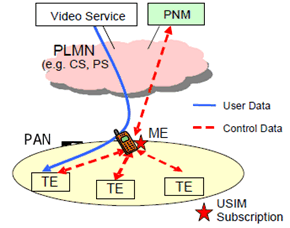
Figure 7: Single network connection through PNE holding the (U)SIM of PAN
(⇒ copy of original 3GPP image)
(⇒ copy of original 3GPP image)
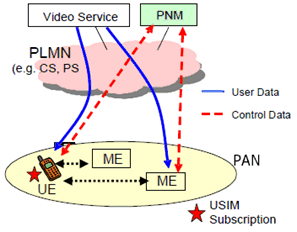
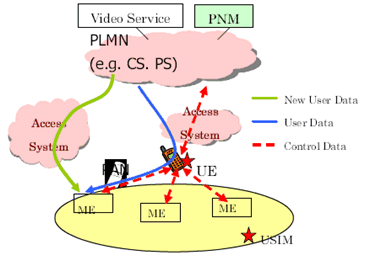
A.4 Use case for connection between guest UE and PN p. 20
The Guest UE is registered into the PN after authentication mechanisms. This use case describes an example where the Guest UE belongs to a different service provider. Once registered into the PN, the Guest UE is allowed to access the PN, based on access control procedures set by the PN user for the particular Guest UE. For example, in fig 10 given below, the Guest UE is allowed to access the video service that the PN of the PNE holding the (U)SIM offers. That is the Guest UE is chosen for the termination of the specific service of video that the PN offers, The PNM facilitates this by secure authentication, registration and routing of the Guest UE.
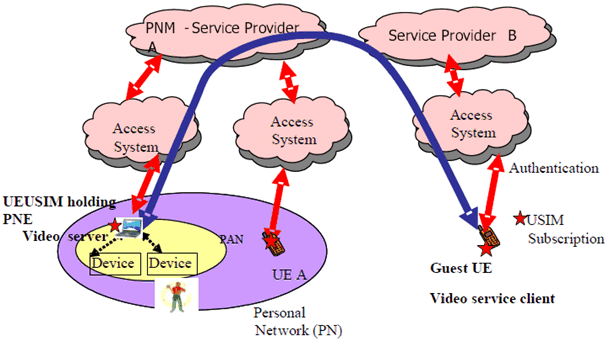
A.5 Use case on UE redirection of terminating services p. 21
A user owns two phones, a PDA, and a notebook. All devices have radio access means to the 3GPP System. Phones and PDA support UTRAN. The notebook allows access via WLAN. The user has subscribed the PNM PN UE redirection and registered all devices in the Personal Network.
In a possible scenario the user is on an airport and must wait for a delayed plane. The user carries the notebook and one of the phones with her/him. The other two devices are left at home. Usually the user does not use the notebook for accessing 3GPP services. However, an Interworked WLAN access network may exist at the airport. Via the WLAN hotspot the user is able to establish a connection to the PLMN. To shorten the waiting time the user wants to utilize the WLAN hotspot for enjoying subscribed 3GPP multimedia services via the notebook. The services are configured for the termination at PDA and phones. The user needs a convenient solution to enable a temporary termination of the services with the notebook in order to benefit from the available advanced multimedia processing capabilities of the notebook and the high speed data access. Depending on the services the user would have to reconfigure either the services or the devices. In case of device reconfiguration a forwarding function would have to be set up at the phones and the PDA for directing services to the notebook. This is not only inconvenient but currently not feasible for the user as a part of the devices is left at home. Furthermore different redirecting settings would be required for CS and IMS. In praxis the complicated manual handling would hamper the flexible use of the available devices. Instead the user wants to switch on the notebook and press a button to activate the notebook for the service termination either temporarily or permanently. Depending on the user preferences the user interface may also offer to activate a specific subscribed service, like a multimedia news service. Beside of the minimized manual interaction the handling would be more natural. When the user wants to do something with a particular device the user does not expect the necessity to configure other entities. After finishing the usage of the multimedia services the user presses the deactivation button to stop a temporary activation. In non-temporary cases the activations are changed by activating one or more other devices at a later point in time. For instance, back at home the user may prefer to use the PDA for receiving the multimedia news. After switch-on the user simply presses the activation software button on the PDA to either receive the news exclusively or simultaneously on the PDA.
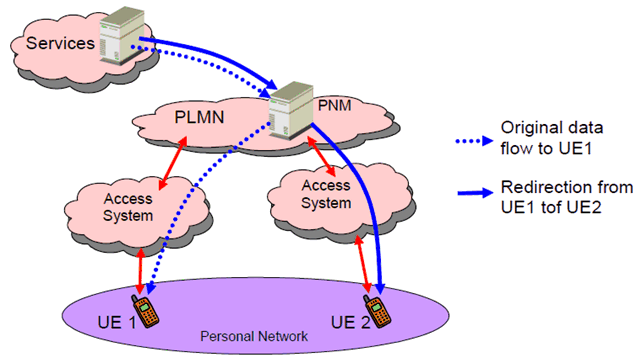
Figure 11: Activation of UE 2 for directing service termination to UE 2
(⇒ copy of original 3GPP image)
(⇒ copy of original 3GPP image)